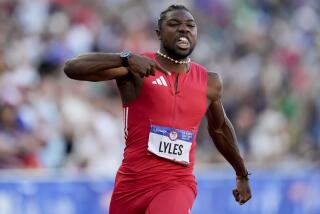He Landed Somewhere in Future
- Share via
In the summer of 1920, Babe Ruth hit 54 home runs, or 30 more in a season than anyone else ever hit before and 25 more than he hit the season before, when he was only a part-time hitter and full-time pitcher. This was widely perceived at the time as, maybe, the outstanding single sports feats of all time.
In 1918, Jack Dempsey knocked out two men, Fred Fulton, and Carl Morris, in a total elapsed time of 32 seconds, including the counts--Morris went 14 seconds, Fulton was tougher, he went 18--and these were considered the standards for pugs to shoot at the rest of time.
On Oct. 18, 1924, Red Grange of Illinois scored 4 touchdowns in 12 minutes the only times he touched the ball, running 95, 67, 56 and 44 yards for scores against Michigan. He later scored twice more, on a run and a pass reception, and that was the day he became the Galloping Ghost, the spectral runner against whom all subsequent ball carriers were to be measured.
On March 2, 1962, at Hershey, Pa., Wilt Chamberlain threw in 100 points in a pro basketball game, 22 more than his previous high and 29 more than anyone else ever had.
On June 10, in 1977, in the second round of the Memphis Open golf tournament, Al Geiberger shot 11 birdies and an eagle and took only 23 putts to shoot an unheard-of 59, lowest round in pro tournament golf history.
Extraordinary achievements all. But, almost without question, the most incredible single athletic feat of all time took place on Oct. 18, 1968, at 3:46 p.m. in the gathering gloom of the Olympic long jump pit at the stadium in Mexico City. Bob Beamon jumped 29 feet 2 1/2 inches.
It was one of the glowing moments of sports history when everything comes together almost in a flash of insight, almost as if the athlete were standing outside of himself watching, too.
Bob Beamon was in the air just shorter than the Wright Brothers. No one had ever been aloft that high or that long over a long jump pit before--or since. It wasn’t a jump, it was an orbital flight.
Beamon didn’t break the record, he disintegrated it. It was not only how far he had jumped, it was how high. Some thought he might have broken the high jump and long jump records at the same time.
“I thought he never would come down,” I remember runner-up Ralph Boston marveling.
Rumor had it Beamon came up on the traffic controllers’ screens at the airport. They thought he was the noon flight from Guadalajara. Lindbergh didn’t get that high off the deck.
No one had ever jumped 28 feet before. The world record was 27 feet 4 3/4 inches and the machine designed to measure the long jump at the Mexico City Olympics that year had a nervous breakdown. The optical device could not digest the information being fed back to it.
It could not, in effect, believe its eyes. It had been constructed to measure jumps of 28 feet. Everyone thought that would be enough to measure any jump on the planet Earth by any creature that didn’t have horns or spots.
Bob Beamon broke the long jump record by nearly 2 feet--by 19 3/4 inches to be exact. He broke the Olympic long jump record by almost 3 feet--31 inches to be exact.
“He has broken the Olympic record by a half century,” the British long jumper, Lynn Davies, said later. “He has destroyed the event.”
It was an enormous mark. It was like a man hitting 80 home runs, batting .502, shooting 50, winning Wimbledon love-love-love. It is an Olympic record not likely to be broken in our lifetimes.
It has had the extraordinary effect of making Bob Beamon a bigger celebrity as his achievement fades into antiquity. It is usual, 20 years after the event, for a public to have difficulty remembering either one.
But in the 20 years since the Jump, Beamon has seen the Olympic record, even with the great Carl Lewis on the runways, barely creep to 28 feet--28-0. To be sure, word coming out of Russia is that the Soviets’ Robert Emmiyan has posted a 29-foot jump but the details are sketchy.
Few of us are ever privileged to experience the perfect moment in life. It may come to athletes, it may come to actors or actresses, opera tenors. Maybe even a poet can find words that he has no idea where they’re coming from.
But Bob Beamon has worn his laurel gracefully. He’s not sitting around bars, inviting strangers to buy drinks for “the world’s greatest jumper ever” or showing his gold medal at cocktail parties, Beamon is still trying for that perfect jump, he’s attacking the boards.
He is in town to promote the 1988 Pepsi Invitational meet at UCLA June 5, where the pharmaceutical company he works for, Glaxo, Inc., is sponsoring both the men’s and women’s 100-meter dash.
His long jump may never come down in our time but the jumper came down a long time ago. Beamon became a national spokesman for the treatment of high blood pressure when he found that he, the super athlete of all time in his event, had, of all things, high blood pressure.
It is, Beamon points out, a disease without symptoms. Usually, the first indication you get of it is death. Almost 50% of the people who have high blood pressure do not know it--until they die from it. It makes its presence known mainly at autopsies.
It is estimated that 6,315,000 blacks in the United States suffer from it, and that its rate of occurrence in blacks is more than three times that in whites.
This is one record Beamon would rather lower than increase. Lobbying for something as worthwhile as this and bringing the message of his company’s medication is a proper application of athletic fame and if the Jump helps him spread it, Beamon is grateful.
What of the record? Can it be broken at Seoul? Beamon smiles. “Records are made to be broken.”
Maybe so. But it won’t be broken by any 2 1/2 feet.
More to Read
Go beyond the scoreboard
Get the latest on L.A.'s teams in the daily Sports Report newsletter.
You may occasionally receive promotional content from the Los Angeles Times.










